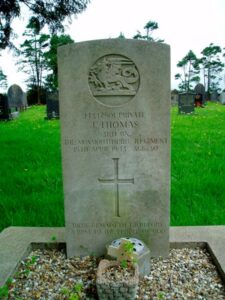Llansteffan is a picturesque village which sits about seven miles south of Carmarthen, just above the junction of the Tâf and Tywi estuaries on the River Tywi. The village is overlooked by its fine 12th Century Norman Castle, and was once a thriving fishing community. The men of the village who fell during both World Wars are commemorated on two plaques which adorn the front of the village Memorial Hall. There is also a plaque within St. Steffan’s Church which commemorates four of its parishioners who fell during the Great War. Many thanks are due to Eiluned Rees of the Llansteffan Historical Society for her kind help in taking photos of the War Memorials and War Graves in the locality.
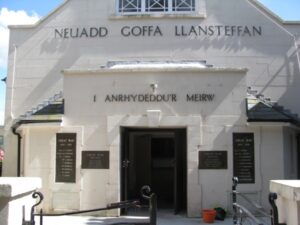
Boer War, 1899-1901
William Ivor Morgan, Lance Corporal, Midland Mounted Rifles. William was the son of John and Ann Morgan, of Llansteffan. His father was the Head of the National School, but after his death in 1894, Ann had moved the family to Huddersfield. William emigrated to South Africa, and joined the Midland Mounted Rifles. He was Killed in Action near Waterkloof, Mortimer on 20 June 1901, aged 20, and is buried at Cradock, Eastern Cape. It is not presently known if there is a memorial at Llansteffan to William, but he is commemorated on the County Boer War Memorial at Carmarthen. His brother John Herbert Morgan was killed during the Great War.
The Great War, 1914-1918
William Wood Brailsford, Private, 1050, Australian Imperial Force. William was born in Llansteffan in 1885, the son of Thomas Stanley Brailsford and Martha Anne Brailsford. The family later moved to Highwood, Peaks Hill, Purley. William emigrated to Australia prior to the war and worked in Tasmania as an Orchardist. On 6 April, 1915 William enlisted at Claremont, Tasmania into the 2nd Pioneer Battalion of the Australian Imperial Force, and embarked on H.M.A.T. Ascanuis on 20 June, 1915. He was part of a reinforcement batch bound for Gallipoli, and arrived at Alexandria on 4 September, 1915. William arrived soon after at ANZAC Beach, Gallipoli, but by 25 September he was admitted to Hospital suffering from Gastritis, and shipped from ANZAC to Heliopolis. It wasn’t until the end of December that William was deemed fit enough to return to his unit, rejoining them at Ismailia. On 6 April, 1916 William transferred into the 31st Battalion, A.I.F., which embarked at Alexandria on 16 May 1916 bound for Marseilles aboard H.M.T. Hororata, arriving on 23 May. The 31st Battalion was attached to 8 Brigade, 5th (Australian) Division, and the Division moved by railway to the Fleurbaix Sector, in Northern France. The Battle for the Somme was about to begin, and a diversion was planned at Fromelles which the 5th Division was to take a full part in. A disastrous attack on 19 July 1916 heralded the opening of the Battle, and in the next few hours the 5th Division was virtually annihilated. William was 31 years old, when he was killed in action on the second day of the Battle, on 20 July 1916, where by now the 31st Battalion alone had lost over 500 men, and he was buried in Rue-Petillon Military Cemetery, Fleurbaix, France. William is not commemorated locally.
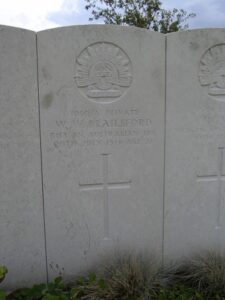
Cyril Raymond Percival Cottrill, Private, TR7/9829, Training Reserve. Cyril was the son of Lieutenant Frederick Percy Cottrill and Bessie Evelyn Cottrill (nee Lamb). The family had lived at Blaencorse Farm, St. Clears and at The Green, Llansteffan for several years, and Cyril was educated at Queen Elizabeth Grammar School prior to the family moving to Southsea. He enlisted at Sandown on 10 July 1916 after having worked in a munitions factory, and was posted to the 94th Training Reserve Battalion, which was based in Hampshire. On 15 April 1917 Cyril was admitted to Chiseldon Military Hospital, suffering from measles, but his medical notes state that he was ‘a pale undersize youth’, and Cyril quickly contracted pneumonia, and died on 7 May 1917, aged 17. He was buried with full military honours in Southampton Old Cemetery. His father was serving at sea with the Royal Navy. Cyril is not commemorated at Llansteffan or St. Clears, but is on the Carmarthen Grammar School War Memorial.
John Tyssil Davies, Lieutenant, Royal Navy. John was born at Llandyssilio on 24 February 1879, the son of the Reverend Daniel Samuel Davies and Margaret Davies. After being educated at Whitland Grammar School, John’s father took up the post of Vicar of Llanybri, and the family moved there as a result. John seems to have served with the Merchant Navy prior to the war, after being awarded his Board of Trade Certificate on 4 September 1906. He then married Sybil Evelyn H. H. Harding in Montgomeryshire in 1908, and the couple set up home at Park Villa, Llansteffan. After the declaration of war, John decided to enlist into the Royal Navy, and served aboard the Transport Ship Pardo before being granted a commission as Sub-Lieutenant into the Royal Naval Reserve on 14 September 1915. John trained at Devonport, before serving at HMS Vivid, HMS Vengeance II and HMS Dido. On 15 May 1917 John was posted to the pre-dreadnought battleship HMS Hindustan, which was attached to the Nore Command, based at Sheerness. John served aboard for several months, and became promoted to Lieutenant. He became ill with appendicitis, and was hospitalised at the RN Hospital Chatham. After undergoing an operation, John sadly died on 21 January 1918, aged 37, and is buried at Gillingham (Woodlands) Cemetery, Kent. John is also recorded on the Whitland Grammar School Memorial, and also at Mumbles, where his brother, Reverend Latimer Davies, was curate of Oystermouth Parish Church. Sybil later resided at 8, St. Helena Road, Westbury Park, Bristol, and died at Weston-Super-Mare in 1963.
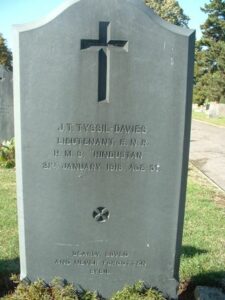
John Davies, Private, 320373, Welsh Regiment. John was the son of John and Mary Davies, of Factory Road, Llansteffan, and lived at Glyn Cottage, Llangain. He enlisted at Carmarthen into the Pembroke Yeomanry in June 1915, and moved to Egypt with the battalion in 1916. The Pembroke Yeomanry merged with the Glamorgan Yeomanry in 1917 to form the 24th Battalion, Welsh Regiment, which was attached to 231 Brigade, 74th (Yeomanry) Division. The division had been formed in Egypt in January 1917 and took part in the march through Palestine, fighting at the three battles of Gaza, before finally capturing Jerusalem at the end of the year. John was killed at the Third Battle of Gaza on 6 November 1917. He was 34 years old, and is buried at Beersheba War Cemetery, Israel. John left a widow and two children. His brother, William Charles Davies, also fell.
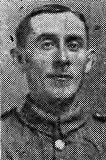
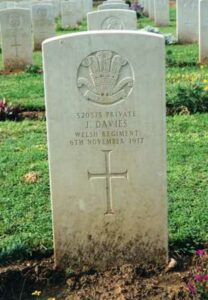
William Charles Davies, Private, 3365, 10th Battalion, Australian Imperial Force. William was the son of John and Mary Davies, of Dyffryn Factory, Llansteffan Road, Carmarthen. William had emigrated to Western Australia in 1909 and found work as a Groom near Blackboy Hill. He enlisted there on 17 October 1916 into the Australian Infantry. William embarked at Fremantle aboard the H.M.A.T. Berrima, and arrived at Devonport on 16 February 1917. After several months in camps at Larkhill and Dorrington, where William was court martialled for being Absent Without Leave (for over a week), William was sent among a batch of reinforcements to the 10th Battalion, arriving in France on 22 August 1917. His papers show that he was wounded in Action on 1 October that year, rejoining the Battalion four days later. The next entry in his papers shows that he deserted his post on 1 January 1918, and was apprehended by the Military Police two days later. His trial on 15 February 1918 ended up in his being awarded five years penal servitude, but on 7 March this was suspended and William rejoined his Battalion at the front. The Battalion was by now in Northern France, and the German Offensive was in full swing, with the Australian Corps in the Borre area. William was killed in action near Borre on 30 May 1918, aged 31 and is buried in Borre British Cemetery. His brother John also fell.

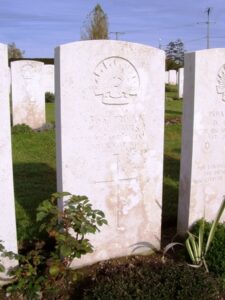
William David Davies, Private, 52657, Welsh Regiment. William was born at Trenewydd, Newchurch on 12 June 1897, the son of John and Mary Davies. The family later resided at Greencastle, Llangain. William worked at his parents farm before enlisting at Cardiff into the Welsh Regiment on 14 August 1916, and was posted to France, where he joined the 9th Battalion, Welsh Regiment, which was attached to 58 Brigade, 19th (Western) Division. William joined the battalion after the Somme battles of 1916. In 1917 the Division moved North to Ypres, taking part in the Battle of Messines, and fought on the Menin Road and at Polygon Wood, before moving up to Broodseinde, Poelcappelle and Passchendaele Village itself. In 1918 they were caught up in the German Spring Offensive near St. Quentin, where they suffered terrible casualties, and fought at the Battle of Bapaume, taking part in a famous action at Beugny. William was wounded at Beugny, and died at No. 7 Canadian General Hospital, Étaples on 25 April 1918, aged 21. He is buried at Étaples Military Cemetery, France.
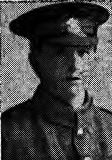
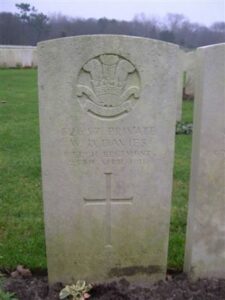
Horace Scott Dowdeswell, Second Lieutenant, Welsh Regiment. Horace was the son of Lieut. Col. William and Amelia Elizabeth Dowdeswell, of Southcove, Porthcawl. He was a regular visitor to his Aunt and Uncle, Major T. H. and Mrs. Dowdeswell, of The Cottage, Llansteffan, and was well known locally. Horace was commissioned into the Welsh regiment, and was posted to Egypt to join the 1/5th Battalion, Welsh Regiment, which was attached to 159 Brigade, 53rd (Welsh) Division. He took part in the advance into Palestine from March 1917 onwards, and was killed in action while leading his company into a storm of Turkish machine gun fire on 3 November 1917. Horace was 19 years old, and is buried at Beersheba War Cemetery, Israel. Horace is not commemorated locally.
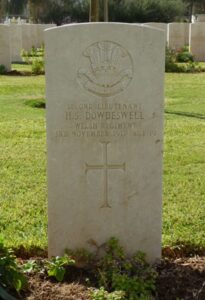
John Evans, Private, 18284, Welsh Regiment. John was born at Llansteffan in 1875, the son of Joshua and Sarah Evans. During the following year the family moved to Ystradfodwg, where Joshua found work as a blacksmith in a coal mine. John worked as a collier for many years prior to enlisting at Pentre into the 9th Battalion, Welsh Regiment on 15 October 1914. Within two months of him enlisting his wife Louisa died, at the age of 38, so their eldest daughter Mary Jane became the guardian to their other four children. The battalion was attached to 58 Brigade, 19th (Western) Division and moved to France on 18 July 1915, and moved with the division to positions near Loos, where it took part in the opening attack of the Battle of Loos on 25 September 1915. The following year the division moved to the Somme, where it took part in the second wave of the attack on Ovillers-La Boisselle on 1 July, capturing the village at heavy cost, and remained in the line until being relieved on 8 July. Its next major action on the Somme was during the Battle of Pozières. On 20 July the 9th Welsh marched to Becourt Wood via Albert and on the following day marched to old trenches in the southern half of Mametz Wood. John was posted as missing here on 21 July 1916. A subsequent court of enquiry later adjudged him to have been killed in action on 21 July 1916, aged 41. His body was later recovered and John is buried in Dantzig Alley British Cemetery, Mametz, France. He is not commemorated at Llansteffan.
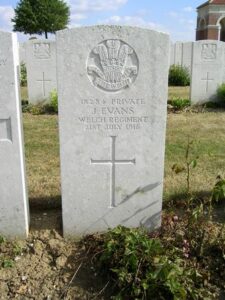
Robert John Hancock, Gunner, 123907, Royal Garrison Artillery. Robert was born at Llanybri in 1881, the son of David and Martha Hancock. The family had moved to Cardiff within ten years, and in 1906 Robert married Evelyn Grace Lock. Robert and Evelyn then lived at Church Cottage, Lavernock, Glamorgan. Robert enlisted at Penarth into the Royal Artillery, and was posted to the 304th Siege Battery, Royal Garrison Artillery, which was attached to XCV Heavy Artillery group. He embarked for the Middles East in 1916 to join his unit, and served in Mesopotamia until contracting malaria. Robert was evacuated to hospital in Alexandria, but died there on 1 December 1917, aged 36 and is buried in Alexandria (Hadra) War Memorial Cemetery. Robert is not commemorated locally.
Joseph Hoare, Gunner, 1410699, Royal Garrison Artillery. Joseph was born in Market Street, Laugharne in 1899, the son of James and Francis Hoare. His father was a Policeman, and by 1911 the family had moved to Bonville House, Llansteffan. Joseph had enlisted in August 1914, at the grand age of 14 years old, and was posted to the Royal Garrison Artillery barracks at Plymouth as a Bugler. He later served in France and in East Africa during the war, returning home on leave in January 1919, before returning to Africa. He was later posted to Ireland during the height of the troubles, attached to the 19th Battery, 5th Brigade, Royal Garrison Artillery. Joseph died after being accidentally shot while on duty in Ireland on 10 June 1921, aged just 21. The Welshman newspaper reported that he had died of self-inflicted injuries, but another report in The Independent stated that he was actually trying to save a comrade who was trying to kill himself and the gun accidentally went off, killing him. Joseph is buried in Llansteffan Churchyard and the base of his CWGC headstone states that ‘He died to save a comrade’, so the Independent article was more likely correct.
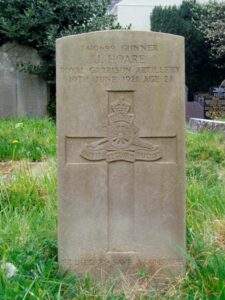
Thomas Howells, Private, M2/046283, Royal Army Service Corps. Thomas was born at Llanybri, the son of John and Mary Howells. The family then moved to Llain, at Llanybri, where Thomas grew up, and his brother William was born. Thomas enlisted at Merthyr into the Army Service Corps, Base Mechanical Transport Depot. John was sent to France in 1915, but took ill and Died of Sickness on 19 January, 1916, aged 36. He is buried in Ste. Marie Cemetery, Le Havre, France. Many thanks to Andrew Devine, the Great Nephew of Thomas, for the photograph of him in uniform. Thomas is also commemorated on the new memorial at Llanybri.
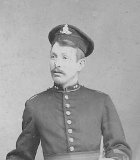
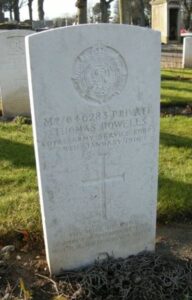
William Howells, Private, 54571, Welsh Regiment. William was the younger brother of Thomas, the son of John and Mary Howells. William had been born at Star House, Llanybri, and enlisted at Carmarthen into the Pembroke Yeomanry. Later William transferred into the 9th Battalion, the Welsh Regiment, which formed part of 58 Brigade, 19th (Western) Division. It is not known when William transferred, but the 19th Division had fought in all of the major battles of the War, at Loos, the Somme and at Passchendaele, and were to meet their sternest tests in 1918. They were in the St. Quentin area when the German Spring Offensive was launched, before moving North to Messines, where they suffered terrible losses. William was wounded at Messines, and was evacuated to the Casualty Clearing Station at Haringhe, West of Ypres, where William Died of Wounds on 15 April 1918, aged 27. He is buried there, in Haringhe (Bandaghem) Military Cemetery, Belgium. William is also commemorated on the new memorial at Llanybri.
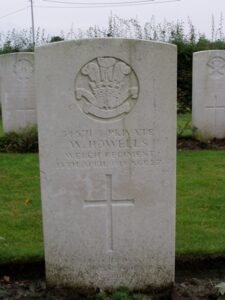
William Howells, Gunner, 122051, Royal Artillery. William was the son of Lewis and Mary Howells, of Trerhos, Llandilo-Abercowin. Following his fathers’ death in 1895, his mother moved to Blaenycwm, and later to Neptune Villa, Ferryside. William became a cowman at Moche Farm, Llansteffan. He enlisted at Carmarthen into the Royal Artillery and was posted to the ‘X’ 32nd Trench Mortar Battery, which was allocated to the 32nd Division. The Division fought on the Somme in 1916, moving to Arras in the Spring of 1918. After the Battles of Arras in 1918, where the German Offensive failed to take the City, the Division moved South to the old Somme battlefield, where the tide was turned against the German advance. From then on, they pushed the Germans back toward the Hindenburg Line, where their offensive had started off, and the 32nd Division fought their final Battle at the Sambre during early November, 1918. William was Killed in Action during this engagement on 4 November 1918, aged just 23. He is commemorated on the Vis-en-Artois Memorial, France.
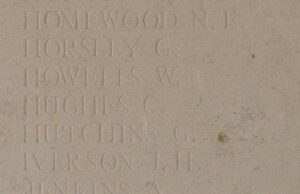
David James, Sergeant, 448350, Royal Engineers. David was born at Llanybri on 19 October 1884, the son of Thomas and Hannah James. He moved to the Smithy, Llanddowror in 1908, and married Margaret Thomas, of St. Clears in 1910. David joined the 2/1st Welsh Field Company, Royal Engineers on 14 November 1914, and was promoted Farrier Sergeant on 27 September 1915. He was sent to the Dardanelles in October 1915 and from there was transferred to Egypt in December that year, when he was transferred to the 437th Field Company. He marched with the Forces from Egypt to Palestine and was present at the Battle of Gaza and other engagements. David was due to return to England in November 1917, and was returning firstly to Palestine on the Aragon when the ship was torpedoed by a submarine on 30 December 1917 and he was drowned, aged 33. David is remembered on the Alexandria (Chatby) Memorial, Egypt. David is also commemorated on the new memorial at Llanybri and also at Llanddowror Church.
John James John, Private, 320374, Welsh Regiment. John was born on 21 May 1895 at Pontygwaith, Tyler’s Town, the youngest child of William and Eliza John. The family later returned to their native Laugharne, living at Halfpenny Furze. John’s brother David had left his young wife and child behind to emigrate to Australia, and John moved to Llansteffan to work on a farm in an attempt to get some money together to join David. The outbreak of war prevented this, however, and John enlisted into the Pembroke Yeomanry in 1915, while David enlisted into the Australian Imperial Force. (David was killed in 1916, see the Laugharne War Memorial page). In 1916 the Pembroke Yeomanry moved to Egypt, and took part in actions against the Senussi Tribesmen. In 1917, the Pembroke and the Glamorgan Yeomanry merged and became the 24th Battalion (Pembroke & Glamorgan Yeomanry), Welsh Regiment, attached to 231 Brigade, 74th Division. After a successful campaign in Palestine, where the 74th Division took part in the capture of Jerusalem, in May 1918 the Division was sent to France, to make up the heavy losses suffered by the British during the German offensives of March and April. The 24th Welsh landed at Marseilles on 7 May 1918, and moved to Northern France. After helping to steady the line in Flanders, the Division moved to the Somme, to take part in the Battle of Épehy, which was part of the move towards the Hindenburg Line. John was killed in action during the 24th Welsh attack on Gillemont Farm on 21 September 1918. He is buried at Unicorn Cemetery, France, just fifteen miles from where his brother David fell.
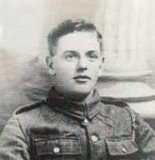
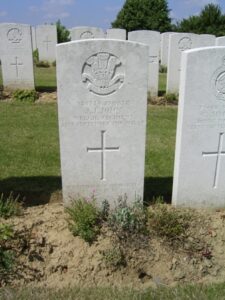
Thomas John, Corporal, 13227, Welsh Regiment. Tommy was born in Llansteffan, the son of David and Elizabeth John. He was raised by his Grandparents, Thomas and Mary John, of 4, Stratford Villa, The Green, and had enlisted at the start of war at Carmarthen. Tommy was wounded during the Battle of Loos, and returned home for treatment spending some time at home in Llansteffan with his family at Stratford Villas, before being sent back to France. Just a few weeks later, Tom was on trench duty at La Bassée when he was shot in the chest by a sniper. He died of wounds on 17 January 1916, aged 32, and was buried in the beautiful setting of the Le Touret Military Cemetery, Richebourg-L’Avoue, France.
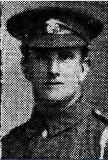
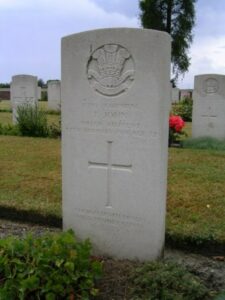
Daniel John Jones, Private, 282285, Lancashire Fusiliers. Daniel was the son of Daniel and Anne Jones, of Cwrt y Carnau, Llansteffan. He enlisted at Carmarthen into the 2/7th Battalion, Lancashire Fusiliers, part of 197 Brigade, 66th Division. The Division were formed on 31 August 1914, but remained at home until the end of February 1917, being used as a source of reinforcements for the 42nd Division at Gallipoli. They concentrated on the Western Front during March 1917 and moved north to the Flanders Coast. On 29 August 1917 Daniel was billeted with some other men in the cellars of a ruined house, when a German shell crashed into the ruins, bringing the roof down on them. Daniel was 24 years old when he was killed in the explosion, and is buried at Ramscappelle Road Military Cemetery, Belgium.
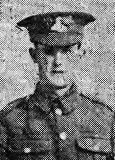
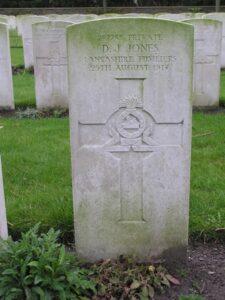
Herbert Jones, Flight Sergeant, 4180, Royal Air Force. Herbert was born in Ynyshir on 5 March 1891, the son of William and Sylvia Jones. The family later resided at 2, Brondeg Cottage, Llansteffan. Herbert enlisted into the Royal Flying Corps on 20 March 1915 and trained with No 16 Training Squadron before being posted to 106 Squadron where he served as a rigger. Herbert survived the war and continued to serve with the Royal Air Force after being posted to India with 28 Squadron in 1919. He died of heart disease in Ambala Military Hospital, India on 26 September 1921, aged 30. Herbert is not commemorated by the CWGC and is not named on the Llansteffan War Memorial.
Thomas Idwal Jones, MM, Lieutenant, London Regiment. Thomas was born in 36, Pier Street, Aberystwyth in 1897, the son of John Thomas Jones, and Amelia Jones. He had been a frequent visitor to his Uncle, Reverend John Coedfryn Davies, at Llansteffan. Thomas had been educated at Alexandra Road School for a year before the family had moved to 27, Park Flats, Hampstead, and he continued his education at St. Olaves Grammar School, Tower Bridge. Thomas enlisted into the 18th Battalion, London Regiment (London Irish Rifles), which was attached to 141 Brigade, 47th (2nd London) Division. Thomas served in Ireland before joining the battalion in France on 22 June 1916. He fought during the Somme offensive that year and was commissioned as Second Lieutenant on 31 December 1916. He was awarded the Military Medal for his bravery on the Somme for “Displaying great coolness and courage when handling his party on September 11th, when they raided the enemy’s trenches, and his example did much to ensure success.” The division fought at the Battles of Messines and Cambrai in 1917, before returning to the Somme in 1918. Thomas was killed in action during the opening days of the advance to victory, on 31 August 1918, aged 21. He is buried in Combles Communal Cemetery Extension, France. He does not appear to be commemorated locally.
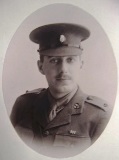
Gilbert Lewis Lloyd, Second Lieutenant, London Regiment. Gilbert was born at Llansteffan in 1888, the son of Reverend William Reece Lloyd and Emily Elizabeth Lloyd. His father had been the vicar of Llansteffan and Llanddarog prior to his death. Gilbert was educated at Lampeter College prior to the war. He had fought in the ranks on the Somme in 1916 before being commissioned into the London Regiment in May 1917 and posted to the 1/21st Battalion, London Regiment (First Surrey Rifles). The battalion was attached to 142 Brigade, 47th (2nd London) Division. Early in 1917 the Division moved north to Belgium, and took part in the Battle of Messines, and then in November 1917 fought at the Battle of Cambrai. Gilbert was killed at Cambrai on 30 November 1917 aged 29. He has no known grave and is commemorated on the Cambrai Memorial, Louverval, France. Gilbert is not commemorated at Llansteffan, but is commemorated at Lampeter College.

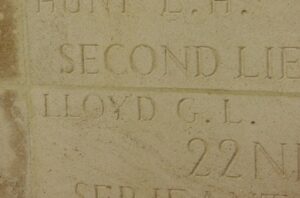
John Herbert Morgan, Lieutenant, Canadian Infantry. John was born at Llansteffan on 6 August 1882, the son of John and Ann Morgan. His father was the Head of the National School, but after his premature death in 1894, Ann moved the family to Huddersfield, Yorkshire. John emigrated to Canada by about 1904 to work as a singing teacher, and had married Edna Sophia Brown at Ontario. He enlisted in Niagara on 3 June 1915 into the 37th Battalion, Canadian Infantry and sailed from Canada on 27 November aboard the SS Lapland, landing in England on 5 December. John transferred to the 20th Battalion, CEF in France on 14 July 1916 after gaining his commission. He served with the battalion during the Somme offensive that summer, and the following year saw action at Vimy Ridge and Ypres. During the early weeks of 1918 the battalion was near Lens, and on 21 February 1918 John was given charge of a working party, which was heading for the Souchez-Ablain Crossing, near Lens, to catch a light railway train to be moved to the forward area. John walked in front of a train which he hadn’t seen, and died of his injuries that same day. He was 35 years old, and is buried in Aix-Noulette Communal Cemetery Extension, France. His brother, William Ivor Morgan, was killed during the Boer War. Neither brother is commemorated at Llansteffan.
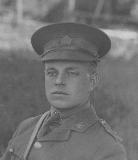
Thomas Voyle Morgan, Private, 951, Welsh Guards. Thomas was born at Cothi Bridge, the son of John and Elizabeth Morgan. The family had moved to Bonvil House, Llansteffan prior to 1891, where his father was a Police Constable. Thomas followed in his father’s footsteps, and by 1911 had moved to Merthyr Tydfil, where he worked as a Policeman. Thomas married Mary Jane James at Merthyr in 1915 after having enlisted there into the Welsh Guards. The Welsh Guards were formed by Royal Warrant on 26 February 1915, and had joined 3rd Guards Brigade, Guards Division in France. The Welsh Guards saw their first action at the Battle of Loos in September 1915. After Loos, the Guards were brought out of the lines, spending time at Calais recuperating. From here they moved to Ypres in where they spent time again in the front line, where Thomas was wounded. He was brought back to the Base Hospital at Etaples, where he Died of Wounds on 25 May 1916, aged 27. He is buried in Etaples Military Cemetery, France.
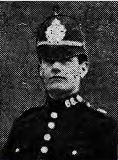
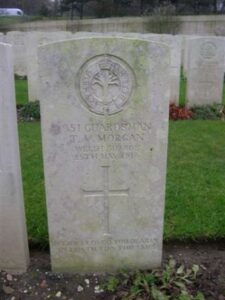
John Morris, Private, 79395, Royal Army Medical Corps. John was born in Llangain in about 1884, the son of William and Anne Morris. The family lived in Tycanol, Waunfort, Llanstephan Road and John worked as a Mental Nurse at Carmarthen prior to the war. He enlisted at Carmarthen on 29 November 1915 into the Royal Army Medical Corps and was stationed in England before embarking for India on 23 September 1916. John served in India for over two years with the 38th Company, RAMC before contracting malaria and died in the 34th (Welsh) General Hospital at Deolali on 3 July 1919, aged 35. He was buried in Deolali Government Cemetery, India, where he still lies today. John does not appear to be commemorated locally.
James Stanley Phillips, Private, 39605, South Wales Borderers. James was born in 1897, the son of David and Anne Phillips, of Parcnwc, Llansteffan. James’s mother Anne was a Laugharne girl, the daughter of Mr and Mrs Thomas, Castell-Toch. Early in 1917, James was drafted into the army, where he became a Private in the 2nd Battalion, South Wales Borderers, which was attached to 87 Brigade, 29th Division. The Division had landed at Marseilles on 29 of March 1916 after a torrid spell at Gallipolli, before fighting at the Battle of the Somme in 1916, and through the Battles of the Scarpe, near Arras, through the beginning of 1917. On 7 June 1917, the Flanders Offensive was begun around Ypres. The following battles were to become known as Third Ypres or Passchendaele. On 16 August 1917, the Battle of Langemarck began. This area, just North of Ypres, had become a hellhole. The continuous bombardment of the German Front Lines had turned the battlefields around Ypres into a quagmire of foul, sticky mud, full of the debris of three years of non-stop fighting. James was killed in action that day, aged just 20 years old. As happened to so many other men that fought in that area, his body was lost in the mud, and so he is commemorated on the massive Tyne Cot Memorial, Belgium. At the very time that James lost his life, his mother also had the agony of her elder brother in an Army Hospital in Birmingham having his leg amputated after a terrible wound suffered in France.
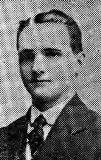
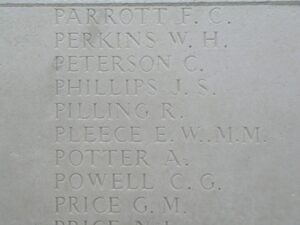
W. H. Rees, Sapper, Royal Engineers. The Carmarthen County War Memorial of 1922 has this man listed on it, but no records can be found of him, and he is not on the War Memorial at Llansteffan.
James Meredith Richards, Private, 16609, West Riding Regiment. James was the son of James L. Richards and Ada Janet Richards, of Pantyrathro, Carmarthen. He was educated at Llandovery from 1911 to 1912, and then was in business in London. In September 1914 James enlisted in the Army at Cardiff, and joined the Dragoon Guards, but was invalided home with a leg wound, and spent some time in Hospital at Manchester. On recovering from his wound, James transferred Regiments, joining the 2nd Battalion, Duke of Wellington’s (West Riding) Regiment. The Battalion was attached to 12 Brigade, 4th Division, and by the time James joined them in July 1916, they were in positions on the Somme, where they fought at the Battle of Albert and the Battle of Le Transloy. On 15 December 1916 the Battalion relieved the Essex Regiment in the front line at Bapaume, in atrocious weather conditions. It is believed that James was killed by a sniper there, on 19 December 1916. He was 22 years old, and is buried at Sailly-Saillisel British Cemetery, France. James is also commemorated on the new memorial at Llanybri.
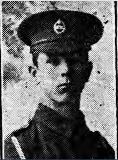
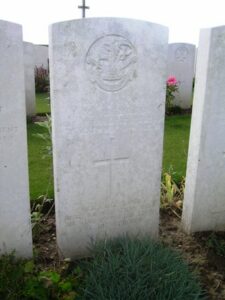
John William Stephenson, Private, 3532, Royal Army Medical Corps. John was born at Barrow. He had moved to West Wales by 1911 to work on the railways, and married Mary Ann Griffiths of Llansteffan in 1910. The couple lodged at Llandebie before moving to Tygate, Porthyrhyd, where their son Percy was raised. John enlisted at York at the outbreak of war into the Royal Army Medical Corps, and was posted to France, where he became attached to the 56th Howitzer Battery, Royal Field Artillery. The Battery was attached to the 2nd Division, which had been in France since the outbreak of war, taking part in the retreat from Mons. John would have seen action at Ypres and at Loos, and was awarded the French Legion of Honour for the Somme in 1916. He was mortally wounded around the time of the Third Battle of Ypres, and died of his wounds on 10 August 1917, aged 32. John is buried at La Gorgue Communal Cemetery, France. His widow Mary moved back to Reservoir Cottage, Llansteffan with their son Percy and died there in 1932. John was awarded the French Croix-de-Guerre just prior to his death. He is not comemmorated at Llansteffan.

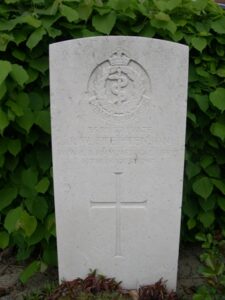
David Arthur Thomas, Second Lieutenant, Royal Welsh Fusiliers. David was the son of the Reverend David E. Thomas and Jennie Thomas of Brynllwyfen, Llansteffan. Prior to the war, David worked on the staff of Lloyds Bank in Llanelli, and enlisted into the Welsh Regiment at sometime in 1915. He was commissioned from the Welsh into the Royal Welsh Fusiliers, and after his training was posted to the 1st Battalion, Royal Welsh Fusiliers. He joined the battalion in France on 23 January 1917, where it was at Arras attached to 22 Brigade, 7th Division. The Battle of Arras began on 9 April 1917 and the 7th Division was moved in front of one of the most strongly defended German positions around Arras, at Bullecourt, which they attacked and successfully took alongside the Australian Corps. David was killed in action here during the attempted consolidation of a captured section of the Hindenburg Line north of Bullecourt on 4 May 1917, aged only 22. He is remembered on the Arras Memorial, France.
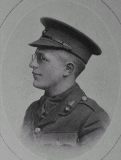
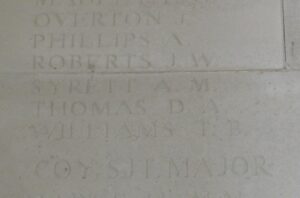
Thomas Trevor Treharne, Private, 63045, Welsh Regiment. Thomas was the son of Thomas and Mary Treharne, of Plas Road House, Llansteffan. He was a builder prior to the war and married Margaret Ann Lloyd at Swansea on 8 August 1908. The couple resided at 2, Ivy Cottage, Llansteffan, where their two children were born. Thomas enlisted at Carmarthen into the Pembroke Yeomanry, and on 15 January 1916 transferred into the Welsh Regiment. He landed in France on 29 September 1917, initially joining the 18th Battalion, Welsh Regiment. On 3 October Thomas was transferred to the 9th Battalion, Welsh Regiment, which was at Ypres attached to 58 Brigade, 19th (Western) Division. After the closure of the Passchendaele Offensive the 19th Division moved to the Somme sector, facing the Hindenburg Line east of Beugny. The division suffered terrible casualties during the German offensive of 21 March 1918, and after several hard days of fighting the battered division was withdrawn to positions near Messines to rebuild. A second German offensive was launched on the Lys on 9 April 1918 and the division was again caught up in heavy fighting. William was wounded at Messines, and was evacuated to 32 Stationary Hospital at Boulogne, where he died of wounds on 24 April 1918, aged 33. He is buried at Boulogne Eastern Cemetery, France.
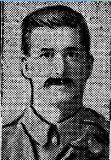
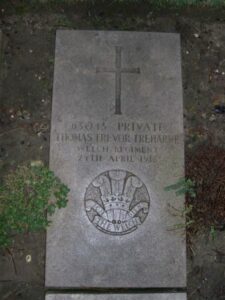
John Tucker, Private, 13406, Welsh Regiment. John was born in Llanybri in 1890. He was raised by his Grandparents Thomas and Martha Tucker at Church Cottage, Llanybri, and lived with his sister, Sarah George and her husband, at 19, Lady Street, Kidwelly prior to 1911. John enlisted at Kidwelly into the 9th Battalion, Welsh Regiment, which was attached to 58 Brigade, 19th (Western) Division. The Division assembled around Bulford during September 1914. Divisional training was completed near Tidworth, and the Division moved to France during July 1915, taking up positions near Givenchy, north of Loos. The Division fought during the opening attack of the Battle of Loos, which is where John was killed in action on 25 September 1915, alongside his friend Morgan Morgan of Kidwelly. John is buried at Brown’s Road Military Cemetery, Festubert, France. John is also commemorated on the new memorial at Llanybri.
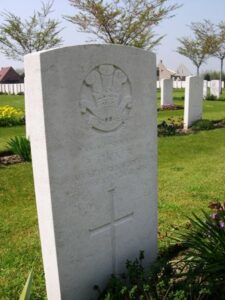
Arthur Williams, Private, 55462, Royal Welsh Fusiliers. Arthur was born at Llanybri and worked as a farm labourer at Pentowin, Llansteffan prior to the war. He enlisted into the Royal Welsh Fusiliers and landed in France at some time in 1916, joining the 16th Battalion, Royal Welsh Fusiliers, which was attached to 113 Brigade, 38th (Welsh) Division. The Division had been in France since December 1915 and remained there throughout the war, fighting at Armentieres, before being moved South to the Somme, being ordered to capture Mametz Wood. The Division were badly cut up at Mametz, and were pulled out of the line, not being used again for nearly a year, when they took part in the Battle of Pilckem Ridge, part of the larger Passchendaele Offensive. After Passchendaele, they moved South again, to help try and stem the German Spring Offensive, and when the tide had turned the way of the Allies in August 1918, the Division played a major part in the advance that followed to the Hindenburg Lone and beyond. On 8 October 1918 the Division captured Villers-Outreaux, part of the 1918 Battle of Cambrai, and Arthur was killed in action that same day, aged only 21. He is buried at Bois-Des-Angles British Cemetery, Crevecouer-Sur-L’Escaut, France. Arthur is also commemorated on the new memorial at Llanybri.
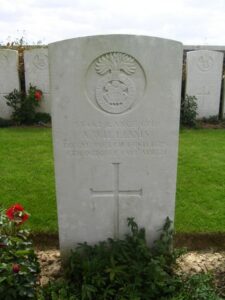
Benjamin Williams, Private, 8001, Welsh Regiment. Benjamin was the son of Thomas and Anna Williams, of Penybank, Llanybri. He enlisted at Cardiff several years prior to the war into the 2nd Battalion, Welsh Regiment. The battalion was stationed at Pembroke Dock at the outbreak of war, and moved to France with 3 Brigade, 1st Division. They fought in the opening Battle of Mons, before fighting a retreat South towards the Aisne, where they stopped the Garman Advance. They moved North again, to La Bassee, then to Ypres, where they withstood the heavy German assault on the ancient fortified City in the Battle of First Ypres. Benjamin had been wounded at the Battle of La Bassée, and was taken to the Duchess of Westminster’s Hospital (No.1 B.R.C.S) at Le Touquet where he died of wounds on 30 January 1915, aged 36. He is buried at Le Touquet-Paris Plage Communal Cemetery, France. Benjamin is also commemorated on the new memorial at Llanybri.
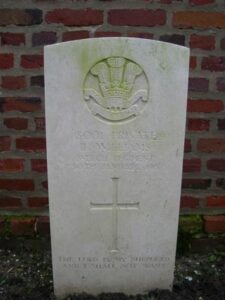
John Daniel Williams, Lance Sergeant, SE/5364, Royal Army Veterinary Corps. John was born in 1866, the son of Mary Williams, of Brook, Llansteffan. He later moved to Burnley, with his wife Ada Williams, of 46, Hollingreave Road, Burnley. He enlisted at Burnley into the Royal Army Veterinary Corps, and served in Salonika from May 1915 until being invalided home. John was then posted to the Woolwich Depot. He died of sickness at home on 26 September 1918, aged 52, and is buried at Hurstwood General Baptist Chapelyard Burnley. John’s name has recently been added to the memorial, as he was not originally commemorated at Llansteffan.
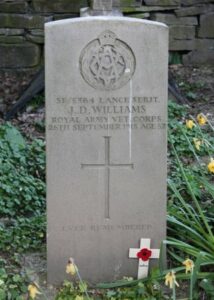
World War Two, 1939-1945
George William Reginald Victor Coventry, Lieutenant, Worcestershire Regiment. George was born on 10 September 1900, the elder son of Viscount Deerhurst and Virginia, only daughter of William Daniel. George succeeded his father as 10th Earl in 1930. He was educated at Eton, and in 1922 contested the Carmarthenshire Division as a Unionist, and was Master of the Carmarthenshire Hounds. In 1921 he married the Honorable Nesta Donne Phillips, of Llansteffan, eldest daughter of the First Lord Kylsant, and they had a son, George William, Viscount Deerhurst, in 1934. George served before the war in the Worcestershire Yeomanry, transferring to the 7th Worcester’s at the outbreak of war. On 4 September 1939 troops of the B.E.F. left Britain for France, and by the end of September over 150,000 British troops had assembled on the French-Belgian borders. After months of desperate fighting, the mighty German Army, with it’s vastly superior armoured divisions, had pushed the B.E.F. back into a small pocket surrounding the French port of Dunkirk, and on 25 May 1940 Lord Gort VC, the Commander of the B.E.F. decided to withdraw his troops from Dunkirk. The 7th Worcester’s meanwhile had been trapped in one of the old WW1 battlefield areas, around Givenchy-Les-La-Bassée, and on 27 May 1940, George was Killed in Action, aged 39. He is buried at Givenchy-Les-La-Bassée Communal Cemetery, France. He was 39 years old. George is not commemorated locally.
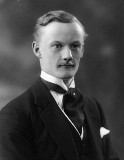
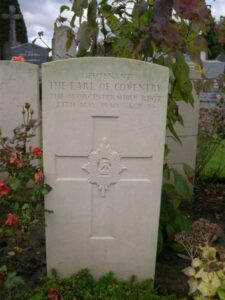
Phillip Thomas Davies, Sergeant, 1152952, Royal Air Force Volunteer Reserve. Phillip was the son of Sydney Arthur Davies and Gwladys Davies, of Llanybri, and enlisted into the R.A.F.V.R., joining 166 Squadron. The Squadron was based at R.A.F. Kirmington from 27 January 1943, operating first Whitley’s, then Wellington’s and Lancaster Bombers. Phillip was one of the crew of Wellington Mk X, Serial LN397 when the aircraft was shot down on a bombing raid on Monchengladbach on 31 August 1943. He is remembered on the Runnymede Memorial, Surrey. He was just 20 years old. There is a memorial to him on his parents grave at Llanybri Churchyard. Phillip is also commemorated on the new memorial at Llanybri.
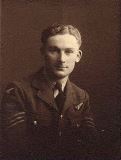
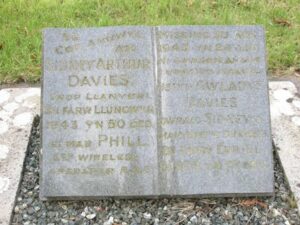
Ivor Lewis Evans, Private, 14541568, Cheshire Regiment. Ivor was born in the Llansteffan area, and served in the 6th Battalion, the Cheshire Regiment, which was created from a doubling up of the Territorial Army at the outbreak of WW2. The 6th Battalion was part of the 56th Division, who were moved from North Africa to take part in the Italian Campaign. On 3 September 1943, the Allies invaded the Italian mainland. Following the fall of Rome to the Allies in June 1944, the German retreat became ordered and successive stands were made on a series of defensive lines. In the northern Appenine mountains the last of these, the Gothic Line, was breached by the Allies during the Autumn campaign and the front inched forward as far as Ravenna in the Adratic sector, but with divisions transferred to support the new offensive in France, and the Germans dug in to a number of key defensive positions, the advance stalled as winter set in. Coriano Ridge was the last important ridge in the way of the Allied advance in the Adriatic sector in the autumn of 1944. Its capture was the key to Rimini and eventually to the River Po. German parachute and panzer troops, aided by bad weather, resisted all attacks on their positions between 4 and 12 September 1944. On the night of 12 September the Eighth Army reopened its attack on the Ridge, with the 1st British and 5th Canadian Armoured Divisions. This attack was successful in taking the Ridge, but marked the beginning of a week of the heaviest fighting experienced since Cassino in May, with daily losses for the Eighth Army of some 150 killed. Ivor was Killed in Action at Coriano Ridge on 18 September 1944, aged just 21. He is buried in Coriano Ridge War Cemetery, Italy. Ivor is also commemorated on the new memorial at Llanybri.
Arthur James, Second Radio Officer, Merchant Navy. Arthur was the son of William and Margaret James of Bridgend, Llansteffan, and the husband of Margaret Mary James, of Abertridwr, Glamorgan. He served with the Merchant Navy as a Radio Officer aboard the S.S. Toronto City, a Bristol registered cargo steamer. At the outbreak of war Toronto City was requisitioned by the Admiralty and used for meteorological service. On 2 July 1941 she was at work in the middle of the North Atlantic when she was torpedoed and sunk by the German submarine U-108. Arthur was 30 years old when he died that day, and is commemorated on the Tower Hill Memorial, London.
E. H. Jones, Lance Corporal, Auxiliary Territorial Service. This woman cannot presently be identified, but served with the Women’s Auxiliary Territorial Service.
Thomas Lloyd, Sergeant, Home Guard. Thomas was the son of Jane Lloyd, and the husband of Hannah Mary Lloyd, of Llangain. Being too old for overseas service, he served at home in the 1st (Carmarthenshire) Battalion, the Home Guard, and Died at home, aged 45, on 22 July 1941. He is buried at Llangynog Churchyard. Thomas is also commemorated on the new memorial at Llanybri.
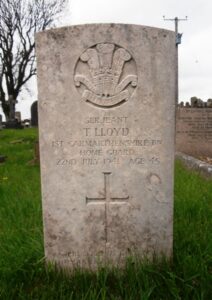
William John Rogers, Gunner, 1747903, Royal Artillery. William was born at Llanybri, the son of John and Margaret Rogers, and the husband of Sarah Mary Rogers, of Llanybri. He joined the Royal Artillery at the outbreak of War, serving in their 313th Battery, 4th Heavy Anti Aircraft Regiment. William was killed on 30 October 1942, aged 35, and is remembered on the Brookwood Memorial, Surrey. He was probably serving as an anti-aircraft gunner aboard the Boom defence vessel Panorama. The Brookwood Memorial serves to commemorate members of the UK land forces who died in WW2 and who have no known graves. The majority of the names on the memorial are of people lost at sea, or whose burial sites are not known. William is also commemorated on the new memorial at Llanybri.
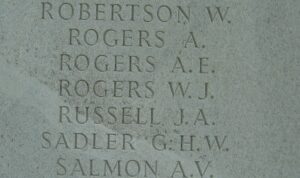
Thomas Mansel Stephens, Lieutenant, 1st Regiment, Special Air Service. Thomas was born on 31 May, 1920, the son of Mr. and Mrs. T. B. Stephens, and he resided in the Grove, Llansteffan. He enlisted into the South Wales Borderers, but volunteered for service into the Commandos, before entering the newly formed 1st Regiment of the Special Air Service (S.A.S.). Nicknamed ‘Twm’, Thomas was part of a diversionary assault on occupied France, landing on the night of 6 June, 1944 as part of Operation Bulbasket under the command of Captain John Tonkin. The force consisted of 39 men of ‘B’ Squadron, 1st S.A.S. who were parachuted into France with jeeps, which were dropped by converted Halifax bombers. Each jeep came down on a carrying platform with four parachutes, and were heavily armed with Vickers ‘K’ Machine-guns. Sadly the men were betrayed and their camp was found, and they lost most of the jeeps and men in the resulting fighting. Thomas was wounded and captured by the Germans, and was executed at Verrieres on 8 July 1944 aged 24. He is the sole Military burial in Verrieres Communal Cemetery, where he is entombed in a French family crypt. There is a memorial to ‘Twm’ at Moriah Chapelyard, Llansteffan, but he is not commemorated on the Memorial Hall.
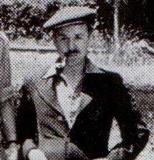
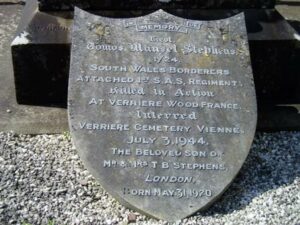
David Rudolph Bentley Thomas (Dolph), Corporal, 14493238, Royal Army Service Corps. Not much is known about ‘Dolph’, as he was known, but he was the nephew of John Thomas of Llansteffan, and a cousin to my Grandfather, John William John. Dolph was educated at Llandovery College prior to being conscripted into the Royal Army Service Corps. He died after the war, on 15 March 1947, aged just 20, and is buried in Llansteffan Churchyard.
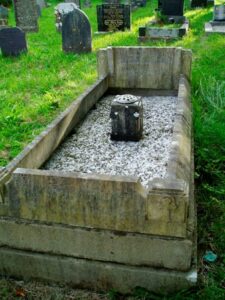
John Thomas, Private, 14342801, Monmouthshire Regiment. John was the Husband of Annie Florence Thomas, of Llanybri. He served in the 3rd Battalion the Monmouthshire Regiment, which was a Territorial Unit, mobilised as part of the 53rd (Welsh) Division in Northern Ireland. It trained in Northern Ireland in 1940 and returned to England in 1941. In the summer of 1942 it was transferred to the 11th Armoured Division and trained for armoured warfare. The Division were to embark for North Africa, but this was cancelled, and they instead landed in Normandy on 14 June, 1944. John didn’t get to France though, as he Died at home on 15 April 1943, aged 30. He is buried in Llanybri Churchyard. John is also commemorated on the new memorial at Llanybri.
